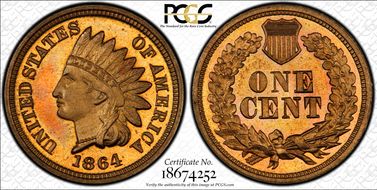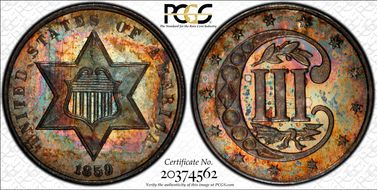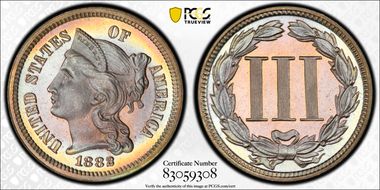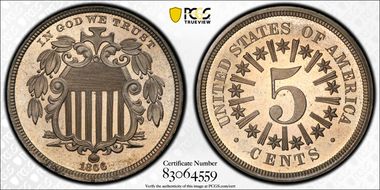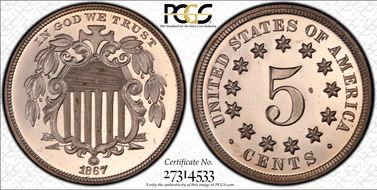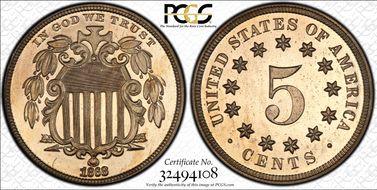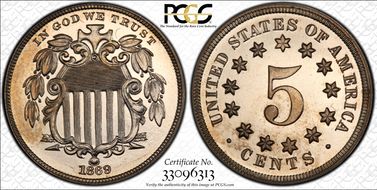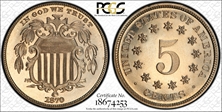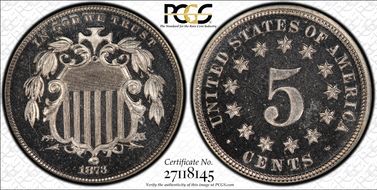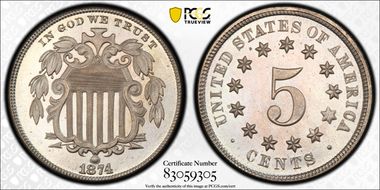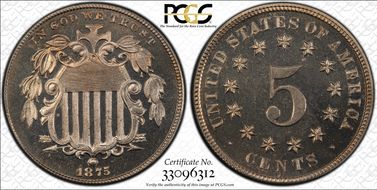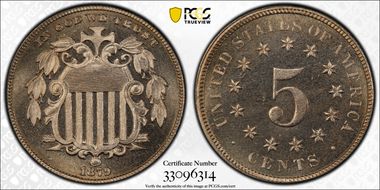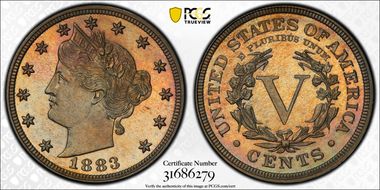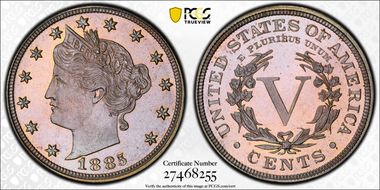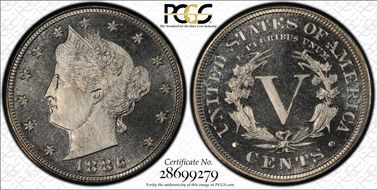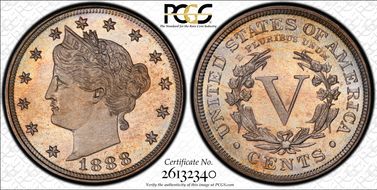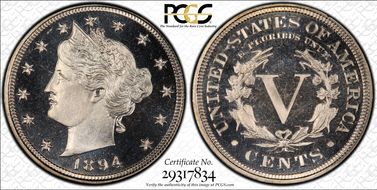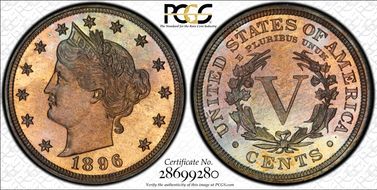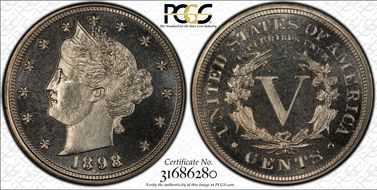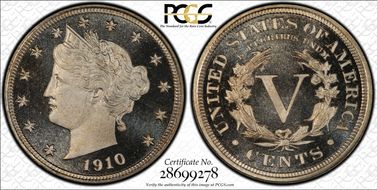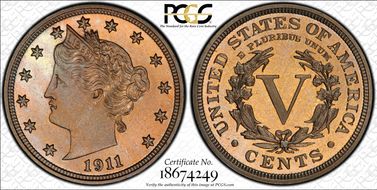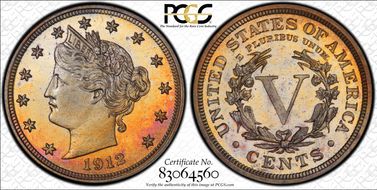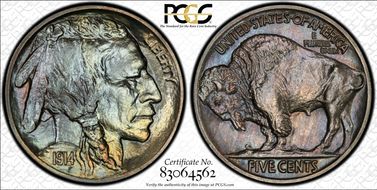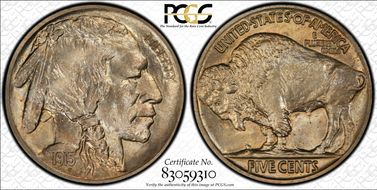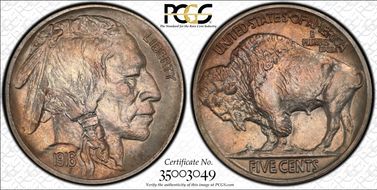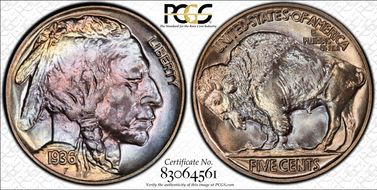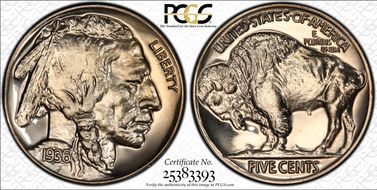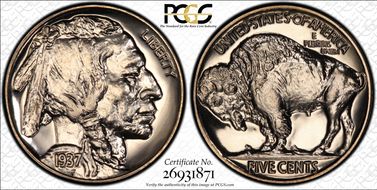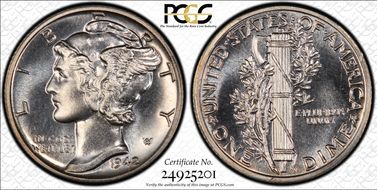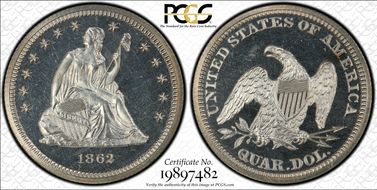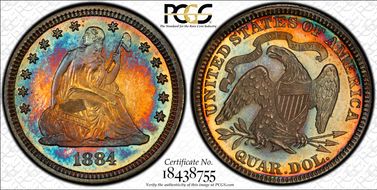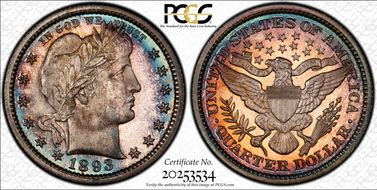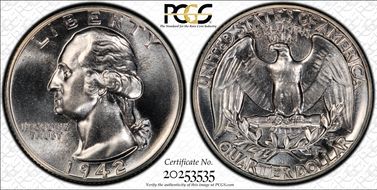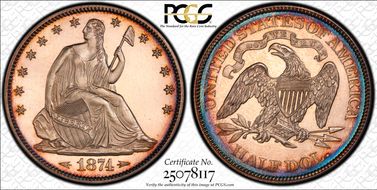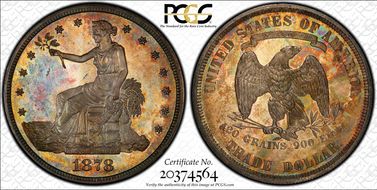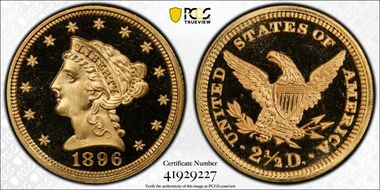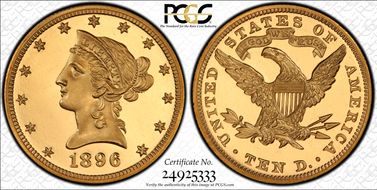Jesh 的钱币相册
CAC. A honey-gold and rose obverse with a solid gold reverse combined with a rare PR66 Cameo make this Indian head cent a beautiful coin. PCGS 5/1 (12/09) PCGS 6/1 (05/15) EX: Five Point Collection
CAC. A honey-gold and rose obverse with a solid gold reverse combined with a rare PR66 Cameo make this Indian head cent a beautiful coin. PCGS 5/1 (12/09) PCGS 6/1 (05/15) EX: Five Point Collection
CAC. Rich gold, green, and blue-plum patina embraces each side of this immensely reflective proof three cent silver. Great eye appeal for early in the series and a simply gorgeous coin, appreciably better-preserved than the "PR65" label on the insert in the first-generation holder.
CAC. Rich gold, green, and blue-plum patina embraces each side of this immensely reflective proof three cent silver. Great eye appeal for early in the series and a simply gorgeous coin, appreciably better-preserved than the "PR65" label on the insert in the first-generation holder.
CAC. Reverse Style D. Stars point to right serif of (STAT)E(S) and between AM. The obverse die is Dannreuther-1, same as on the rare 1867 Rays, with left serif of 1 over right half of a dentil, detached bottom leaf left of the shield, and recutting on the 7. According to research by John Dannreuther, this obverse was used first to strike With Rays proofs on or before Feb. 8, 1867, then No Rays proofs (as here), then more With Rays proof in a later die state. This No Rays Gem shows profound contrast and equal eye appeal over quicksilver surfaces that show no trace of color. A loupe reveals faint recutting on a couple of the reverse stars, but aside from a couple of tiny dark flecks there is little evidence of any post-Mint distractions. 1/0 (7/12) 1/1 (5/13) 1/3 (12/15)
CAC. Ex: Eliasberg. Graded PR67 in its Eliasberg auction appearance, and the piece appears essentially as made even when after prolonged study beneath a loupe. Precisely struck and nearly untoned. PCGS 14/0 (2/09) PCGS 19/4 (5/15) Ex: Edouard Frossard, 3/1894; J.M. Clapp; Clapp estate, 1942; Louis E. Eliasberg Collection (Bowers and Merena, 5/1996), lot 757.
CAC. Ex: Eliasberg. Graded PR67 in its Eliasberg auction appearance, and the piece appears essentially as made even when after prolonged study beneath a loupe. Precisely struck and nearly untoned. PCGS 14/0 (2/09) PCGS 19/4 (5/15) Ex: Edouard Frossard, 3/1894; J.M. Clapp; Clapp estate, 1942; Louis E. Eliasberg Collection (Bowers and Merena, 5/1996), lot 757.
CAC. This stunning piece fully merits the Cameo label, with excellent field-device contrast over the lightly gold-kissed surfaces. A real beauty in hand. PCGS 11/0 (11/09) PCGS 13/0 (11/13) PCGS 18/0 (05/15)
CAC. This stunning piece fully merits the Cameo label, with excellent field-device contrast over the lightly gold-kissed surfaces. A real beauty in hand. PCGS 11/0 (11/09) PCGS 13/0 (11/13) PCGS 18/0 (05/15)
CAC. 1/0 (5/13). 2/0 (4/18). The mirrors are clean, clear, sleek, and have moderate depth and reflectivity. Both sides are an ORIGINAL nickel/lilac/pale gold color. Miss Liberty and the details are needle sharp in strike and have light frost. The eye appeal is beautiful!
CAC. Business strikes of 1886 are important key issues in the Liberty nickel series, adding demand to the surviving proofs. This Premium Gem Cameo proof has excellent contrast with brilliant light gray surfaces and wonderful eye appeal. 3/2 (12/13) 3/2 (1/14)
CAC. The mirrors are deep but do have some very light golden/lilac toning. Miss Liberty and the details are lightly frosted and have needle sharp strikes. PCGS 2, 6 Higher (7/12) 2/6 (5/13)
CAC. The mirrors are deep but do have some very light golden/lilac toning. Miss Liberty and the details are lightly frosted and have needle sharp strikes. PCGS 2, 6 Higher (7/12) 2/6 (5/13)
CAC. Among business strike Liberty nickels, the 1896 is known as an important date that is elusive in high grades. For that reason, many collectors opt for the more available proof example. This Superb Gem proof, a fully struck specimen, is virtually flawless and features amazing gold and rainbow toning on each side. 3/0 (9/12), 3/0 (1/22). Purchased non CAC.
CAC. Discounting the clandestine 1913 issue, the 1907 Liberty Head nickel boasts the lowest proof mintage of the series, at 1,475 pieces. This sharply detailed Premium Gem exhibits distinct cameo contrast between the frosty devices and the deeply mirrored fields. 12/4 (5/13) 12/4 (1/14)
CAC. 1/0 (12/13) This example has bold design elements with pristine surfaces, deeply mirrored fields, highly lustrous devices, and only a hint of delicate champagne toning.
CAC. With 1,733 specimens struck, the 1911 is among the lower-mintage proof Liberty nickel issues, and it rarely comes so fine as this PR67 Cameo example. Excellent field-to-device contrast persists through rich patina, zones of aquamarine and peach. Carefully preserved and gorgeous. Population: 7 in 67 Cameo, 0 finer (2/09)
CAC. With 1,733 specimens struck, the 1911 is among the lower-mintage proof Liberty nickel issues, and it rarely comes so fine as this PR67 Cameo example. Excellent field-to-device contrast persists through rich patina, zones of aquamarine and peach. Carefully preserved and gorgeous. Population: 7 in 67 Cameo, 0 finer (2/09)
CAC. This extremely flashy Superb Gem remains free of toning and displays bold detail. The surfaces of this example are virtually pristine other than a small depression near the bison's front hooves. Only 12 examples have achieved numerically higher grades from PCGS (12/12). From The Richard P. Ariagno, M.D. Collection. 434/32 (5/13)
CAC. Both sides are covered by deep, clear, clean (there are only a few light stray lines), and highly reflective mirrors. The contrast is vivid and there is NO toning anywhere. Miss Liberty and the details are boldly frosted and are fully struck.
CAC. Both sides are covered by deep, clear, clean (there are only a few light stray lines), and highly reflective mirrors. The contrast is vivid and there is NO toning anywhere. Miss Liberty and the details are boldly frosted and are fully struck.
CAC. An incredible Choice Cameo proof, this Seated Liberty quarter is fully brilliant with nary a trace of toning on either side. All of the design motifs are boldly detailed with frosty silver luster inside a mirrored frame. Population: 5 in 64 Cameo, 5 finer (8/10). - 6/6 (5/13)
CAC. An incredible Choice Cameo proof, this Seated Liberty quarter is fully brilliant with nary a trace of toning on either side. All of the design motifs are boldly detailed with frosty silver luster inside a mirrored frame. Population: 5 in 64 Cameo, 5 finer (8/10). - 6/6 (5/13)
CAC. An absolutely incredible Gem proof that has gorgeous gold, violet, and blue toning on each side. The devices are boldly defined and lustrous, with surrounding deep mirrored fields, creating excellent contrast. (Upgrade from PR65).
CAC. An absolutely incredible Gem proof that has gorgeous gold, violet, and blue toning on each side. The devices are boldly defined and lustrous, with surrounding deep mirrored fields, creating excellent contrast. (Upgrade from PR65).
CAC. The 1893 was considered an afterthought by many contemporary collectors, after the issuance of the first-year 1892. But the 1893 is equally well produced and makes a wonderful type coin. This piece appears to us to have enough frost over the devices to warrant a Cameo designation, but apparently PCGS disagreed. The centers are mostly untoned and the margins are accented with rich rose and cobalt-blue toning. Population: 1 in 66+, 18 finer (1/11)
CAC. The 1893 was considered an afterthought by many contemporary collectors, after the issuance of the first-year 1892. But the 1893 is equally well produced and makes a wonderful type coin. This piece appears to us to have enough frost over the devices to warrant a Cameo designation, but apparently PCGS disagreed. The centers are mostly untoned and the margins are accented with rich rose and cobalt-blue toning. Population: 1 in 66+, 18 finer (1/11)
CAC. Razor-sharp definition is apparent on all design elements, and the frosty devices contrast boldly with the deeply mirrored fields. The surfaces are virtually pristine and display attractive champagne-gold and cobalt-blue toning, with the color strongest on the reverse rims. Population: 17 in 64 Cameo, 1 finer (9/11).
CAC. Razor-sharp definition is apparent on all design elements, and the frosty devices contrast boldly with the deeply mirrored fields. The surfaces are virtually pristine and display attractive champagne-gold and cobalt-blue toning, with the color strongest on the reverse rims. Population: 17 in 64 Cameo, 1 finer (9/11).
The mirrors are super clean, have amazing clarity, are deep, and of course have super strong reflectivity. They do appear glass like. A wild mix of ORIGINAL blue/navy/purple/violet/gold colors swirls all over. Miss Liberty and the details are sharply struck and do stand out. The eye appeal is terrific!
The mirrors are super clean, have amazing clarity, are deep, and of course have super strong reflectivity. They do appear glass like. A wild mix of ORIGINAL blue/navy/purple/violet/gold colors swirls all over. Miss Liberty and the details are sharply struck and do stand out. The eye appeal is terrific!
CAC. Patinated in vivid, iridescent shades of green, blue, and lavender, with deeply reflective fields beneath the toning. The boldly impressed devices ensure profound cameo contrast. Population: 31 in 63 Cameo, 25 finer (10/10).
CAC. Patinated in vivid, iridescent shades of green, blue, and lavender, with deeply reflective fields beneath the toning. The boldly impressed devices ensure profound cameo contrast. Population: 31 in 63 Cameo, 25 finer (10/10).
CAC. While the official mintage of 78 proof 1896 ten dollar coins might suggest that the date is relatively available, circumstantial evidence suggests that that output was an overreach. Not only were mintages of proof eagles lower in the next two years (69 and 67 pieces, respectively), but the estimated survival of the 1896 ten dollar proofs is close to that of the 1897, with the 1898 pieces seeing a spike in the survival rate despite a slipping mintage. PCGS suggests that 35 to 45 specimens survive for the 1896 and 1897 dates, compared to "40 to 50 known" for the 1898 issue. The PCGS Population Report lists 25 certification events for the 1896 ten dollar proof, 16 with Cameo contrast and nine labeled Deep Cameo. (It should be remembered that the period from 1896 to 1898 was a high-water mark for the cameo effect in U.S. silver and gold proof coinage.) A majority of the coins are in the PR64 range; among Deep Cameo pieces, this is one of just two certified by PCGS with three numerically finer as Deep Cameo, all graded PR66 (2/12). Effectively black-and-gold contrast is on display with this Deep Cameo Gem, thanks to sharply struck, thickly frosted devices paired with fields that combine so-called "orange-peel" texture with a great overall mirror finish. A thin, curving blemish just off the bridge of Liberty's nose and a depression to the left of star 9 are the most reliable pedigree markers. (Upgrade from 65). PCGS 65DCAM 2/3 (02/12) PCGS 65+DCAM 1/15 (05/15)
CAC. While the official mintage of 78 proof 1896 ten dollar coins might suggest that the date is relatively available, circumstantial evidence suggests that that output was an overreach. Not only were mintages of proof eagles lower in the next two years (69 and 67 pieces, respectively), but the estimated survival of the 1896 ten dollar proofs is close to that of the 1897, with the 1898 pieces seeing a spike in the survival rate despite a slipping mintage. PCGS suggests that 35 to 45 specimens survive for the 1896 and 1897 dates, compared to "40 to 50 known" for the 1898 issue. The PCGS Population Report lists 25 certification events for the 1896 ten dollar proof, 16 with Cameo contrast and nine labeled Deep Cameo. (It should be remembered that the period from 1896 to 1898 was a high-water mark for the cameo effect in U.S. silver and gold proof coinage.) A majority of the coins are in the PR64 range; among Deep Cameo pieces, this is one of just two certified by PCGS with three numerically finer as Deep Cameo, all graded PR66 (2/12). Effectively black-and-gold contrast is on display with this Deep Cameo Gem, thanks to sharply struck, thickly frosted devices paired with fields that combine so-called "orange-peel" texture with a great overall mirror finish. A thin, curving blemish just off the bridge of Liberty's nose and a depression to the left of star 9 are the most reliable pedigree markers. (Upgrade from 65). PCGS 65DCAM 2/3 (02/12) PCGS 65+DCAM 1/15 (05/15)




















